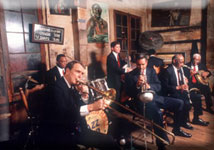


|
|
Jazz
Music Capital |
|||
| ¡@¡@New Orleans is a large city located at the end of Mississippi River, facing the Caribbean. It is considered an important port for both civilian and military in the southern part of America. The French started developing New Orleans in 1718, and they brought 147 African black persons to participate in building the city in 1719. It marked the beginning for the African immigrants. | ||||
| ¡@¡@Since
one must pass through New Orleans on the way from the western Africa
to the eastern America, it has become a city with a large number
of blacks. During the holidays, many blacks from different areas
would gather in the Conga Square. Before the French came to New
Orleans, it was the habitat for the American Indians. After the
French left, this area was once under the Spanish rule, as well
as playing a role in the Civil War. |
||||
| ¡@¡@There
were French explorers in as early as the Seventeenth century, who
reported all the sightings along the Mississippi River back to France.
This area was called Louisiana, which was named after the French
King Louis XIV. But the actual development of New Orleans did not
take place until the Eighteenth century. A French engineer drew
the layout of the streets, which resemble a chessboard. This later
became the 86 streets in the French Quarter. The unique architecture
reflects the influence of Spain on this city. |
||||
| ¡@¡@In the black jazz history, we see many remarkable talents in this city, such as Louis Armstrong, who was born in New Orleans, and he was called the most influential jazz musician in the Twentieth century. Wynton Marsalis, who is called the jazz torchbearer in the Twenty-First century, was also born in New Orleans. This does not mean there are no Caucasian playing jazz music. The first all-white southern jazz band was born in New Orleans. | ||||
| ¡@¡@In 1815, General Andrew Jackson led the soldiers in New Orleans to defend against the British and won. From that day on, the citizens of New Orleans began to be proud of being Americans. General Andrew Jackson would later become America's seventh president. A statue of General Jackson on the horseback was erected in the middle of the Jackson Square. The statue seems to be transformed into a defender for the street performers there, defending New Orleans the capital of music and culture. | ||||
|
||||
| ¡@¡@Unfortunately all the splendor of this city has been washed away by the powerful force of Hurricane Katrina, which brought deep floodwater to eighty percent of the New Orleans area, as well as killing thousands of people. President Bush has declared it one of the most devastating natural disasters in the history of America. In an instant the busy streets of the city were replaced by the empty streets of a ghost town. Two hundred years after its establishment in 1805, New Orleans is now faced with a daunting task of rebuilding after being struck by the disaster of the century. Besides our condolence for the families of the victims, we also feel that the music of Jazz is getting more and more distant, and the sound of saxophone more and more alien. | ||||


